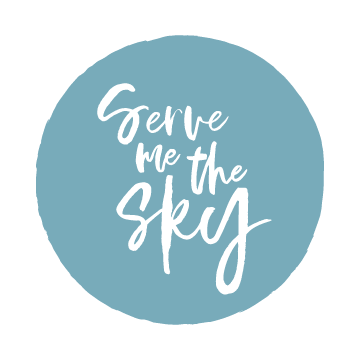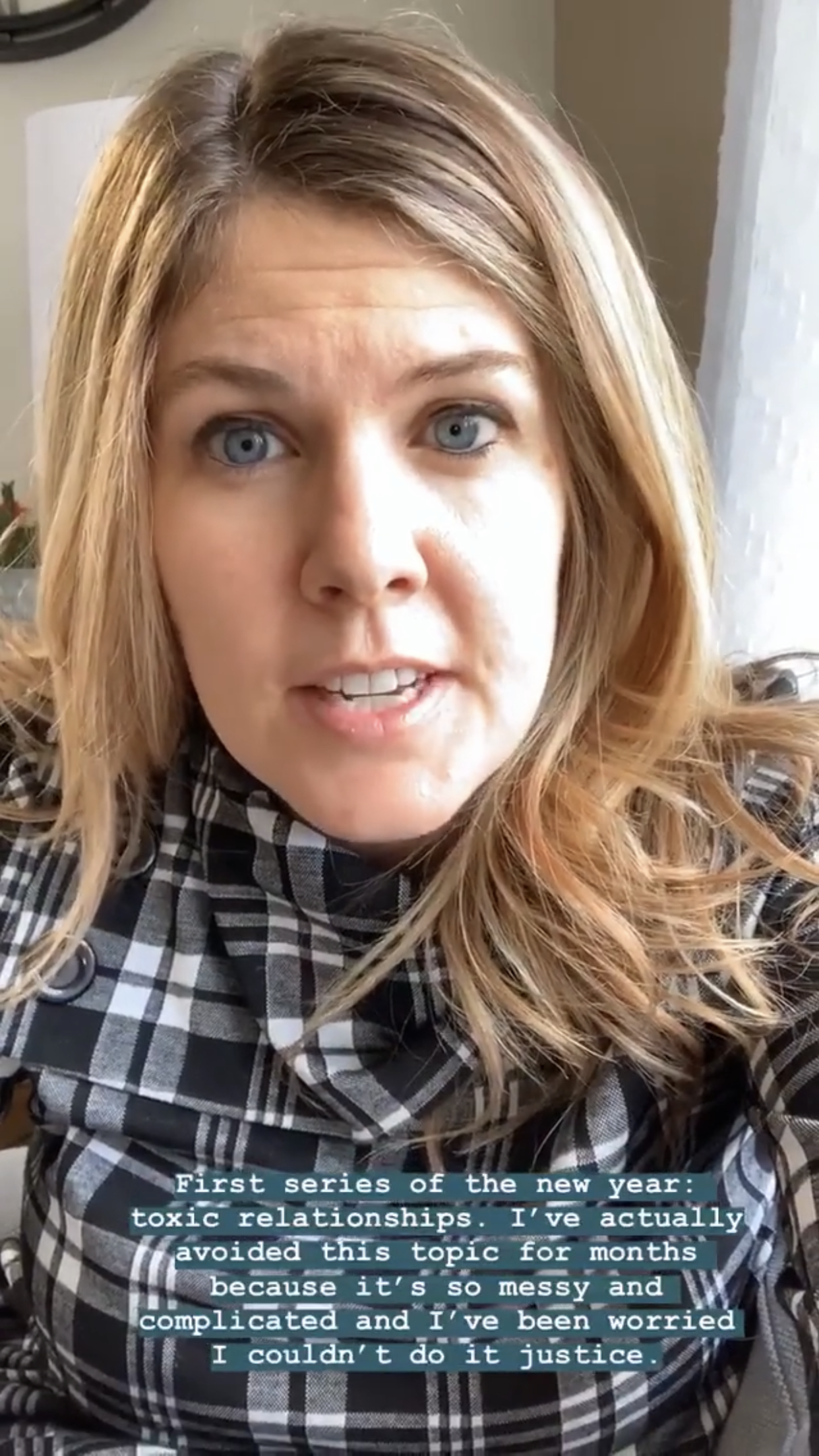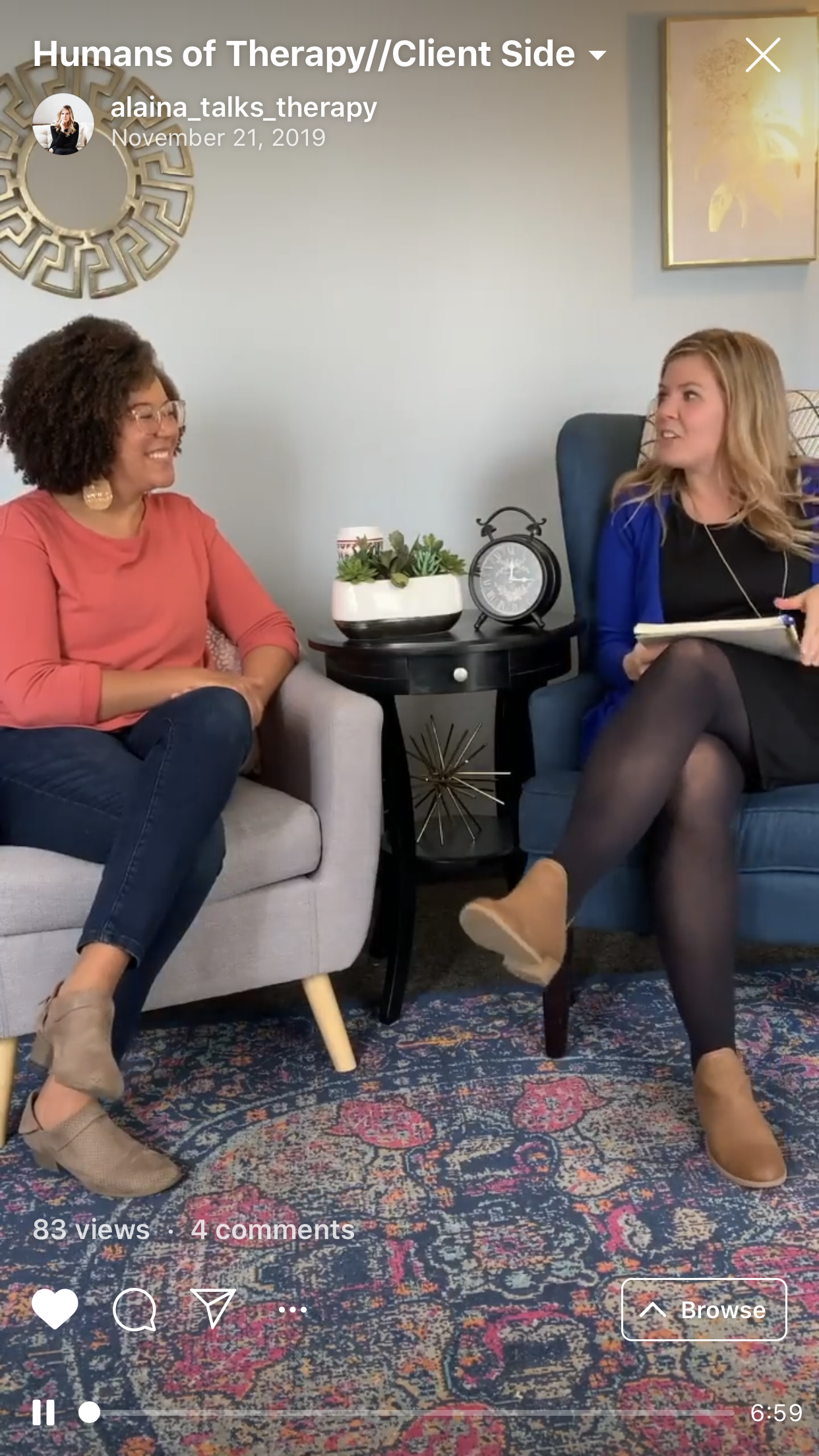A Conversation with Alaina Brubaker: Tips for Getting Started on Instagram
/Therapist Alaina Brubaker launched her Instagram account, @alaina_talks_therapy, in September 2019.
I’m excited to introduce a brand new series on the Serve Me the Sky blog! Each month, I’ll be interviewing folks about various marketing, social media, and communications topics. My hope is to expand beyond my own knowledge and share the expertise of other amazing experts.
Up first in the “A Conversation With” series is an interview with Alaina Brubaker, an experienced therapist who joined Instagram in September 2019 to much success! We discuss what led her to join Instagram, factors that have helped her succeed so far, and some of her best tips for setting yourself up to shine on social media. Enjoy!
How long have you been a therapist? What inspired you to pursue that career path?
I’ve been a therapist for eight years. I’ve always been interested in patterns and what makes people tick. In high school, I was always trying to figure out what motivated someone to do something, or what about their family system made them act a certain way. Once I took a family systems course in college, I was like “There’s a name for what I’ve been trying to do my whole life!” It really connected and made a lot of sense to me. I took a year off between college and grad school to solidify what I wanted to do. I did an internship at a counseling practice where I got to talk to different therapists from different backgrounds, and I was just fascinated by it.
I got my master’s degree at U of R’s marriage and family therapy program. Now, my focus is predominantly on working with women. I probably work with about 80% women and 20% couples. Women’s mental health is really my passion.
What inspired you to get on Instagram?
I’d thought about creating an Instagram for a long time, but I didn’t know what my purpose on Instagram was. I knew I didn’t need it to market and build my business, but I still felt a nudge towards Instagram. I really like writing, and I thought Instagram would give me a space to write and sort through how I’m feeling about something.
A therapist who I respect and follow on Instagram was offering consultations around social media, and it was the push I needed. I thought, “If I’m paying someone to talk about this, then I’d better do it.” I was able to talk to her about ethical issues, legal issues, and boundaries, and get a clear vision of how I could use Instagram.
Another reason for joining was because I hoped Instagram could open new opportunities for me. I’ve been interested in doing consultations with business on mental and emotional health, and speaking at events. Instagram has helped me see what opportunities are out there.
There’s a lot of feedback about needing to be clear about your vision before joining Instagram, like having a specific audience you’re speaking to or a set objective. I was the opposite in my approach. I said, “I’ll try this, engage, and connect with people who I align with, and I’ll see what pops up.”
From right out of the gate, you seemed like a woman with a plan. How much planning went into launching your Instagram?
My sisters helped me strategize- Sarah runs Roc Girl Gang, and Leah works at Truth Collective. Leah walked me through what I wanted to post, what I felt like was reasonable. Sarah helped me with aesthetics and graphic design. My consultation with the other therapist gave me the idea of doing a weekly series, and from there I planned out my first four months of content. Not every single post, but each weekly series.
You select a theme for each week and then explore it in detail. Walk me through your planning process. How do you organize your thoughts and structure the content?
I used to be more structured, but I’ve loosened up. Roughly, the plan is to talk about misconceptions about a topic in Post 1, comparing how people are talking about a topic to what it actually means. For Post 2, I’ll talk more about my own personal experiences with that topic. In Post 3, I’ll offer practical feedback for taking steps to address the topic in your own life.
Do you use a scheduling tool?
I post it all live from my phone. I tried to use a scheduling tool, but I worry about it not working. I try to write all my captions by Sunday, then post them from my phone each day.
Your feed has a certain aesthetic to it. How did you settle on that?
I met with my sister, Sarah, and we went over different color palettes. I gave her colors I liked and she put them in a palette for me. She helped me develop a coherent vision. I mostly knew what I didn’t like- some therapists put a ton of content in their squares and that’s overwhelming to me. I wanted it to look clean, bright, and aesthetically pleasing.
Alaina’s Instagram aesthetic.
Do you create your graphics yourself? Are there any resources you’d recommend?
My sister Sarah will help sometimes, if I send her quotes in advance. I’ve learned a lot and have gotten better at doing it myself, now that I know what I want it to look like. I use AdobeSpark to create my graphics now.
An example of Alaina’s graphics
How far in advance do you plan your posts?
Right now I have maybe three months worth of topics planned out. I’m keeping the same idea of talking about a theme for a whole week, I really enjoy that. It gives me the space to process something and get more deeply into it. There’s less pressure to fit everything clearly and concisely into one post.
Each week in your Stories, you also share a short video of you talking about that week’s theme. What advice do you have for filming content like this?
I’d never done a video on Instagram before. At first, I was recording videos on my phone and uploading them to Stories, so it was really rocky. My sister showed me how to do it right in Instagram!
One thing that’s helped me is to not expect the video to be perfect. My standard is: is this helpful and informative? If it is, then I post. I also give myself just 10 minutes to film it. If I don’t get it, there’s no video that day. I don’t want to spend an hour filming something.
Alaina on camera
Tell me about your Humans of Therapy series. What inspired it? How do you film it, and how much editing do you do?
I loved when I joined Instagram and saw what different people were saying about mental health. People were being really open about going to their therapy, their struggles, and working through them. I wanted to band together and unite our voices.
I film them with a tripod and my phone in my office. I don’t do much editing, I just edit out the part where we sit down and get our giggles out, and the end where we get up and turn the camera off.
Again, knowing how much time I’m willing to spend on something really helps, and sticking to my standard of “is this helpful and informative?”
The first video in the Humans of Therapy series
How do you handle balancing client privacy and the desire to share/educate?
So far I’ve been overly cautious- I don’t want to come anywhere close to breaching confidentiality. Specific examples come to mind for some topics, and even if I completely changed the details, I’m still not comfortable sharing it. It may seem like I’d broken confidentiality. I tend to speak more generally, like “This comes up with my clients a lot.” I talk about things that millions of people struggle with, but nothing so specific that someone could identify a specific person’s struggle. I can still be helpful and relevant.
Some of my clients do follow me on Instagram, and they’ll come in and ask, “Can we do that grounding exercise you posted about?” Clients have the autonomy to bring up things they’ve seen on my Instagram if they want to.
What’s the #1 thing you’ve learned from being on Instagram for about 5 months now?
One big thing is to not take yourself too seriously. Your worth, your identity—those aren’t connected to Instagram. At first, I’d see one post perform really well, and the next receive hardly any likes. I’d start to think, “Maybe I don’t have anything to say, maybe my thoughts aren’t important.” But you can’t put your worth into it. Your worth is separate from Instagram. I’ve had to consciously work on that.
What’s surprised you most since you joined Instagram?
People have been more supportive, positive, and encouraging than I was expecting. I didn’t anticipate the level of engagement that I’ve gotten so far. It’s kept me energized; I honestly didn’t think it would be as fun as it’s been. It’s also been pleasantly surprising meeting different people who are talking about mental health even if they’re not in the mental health world.
Is there anything you would do differently?
I think everything I’ve done so far needed to be part of my process. Even when I was checking how many people had liked a post, that was necessary for me to get to a place of, “Hey, I need to set more boundaries around this.” Those unhealthy things helped me get to a healthier place of balance. It’s all been part of the process of figuring out how I want to use this space and how engaged I want to be.
One thing though- I would have started with more of a mental expectation of “you have permission to not respond right away.” Everything is so fast on Instagram, and I kind of got wrapped up in that. If I don’t have time available to respond in the moment, it’s better to wait and respond later when I can be more thoughtful and intentional.
How do you measure the return on the investment of your time spent on Instagram?
Two ways: one is just a feeling. If I’m feeling energized by it and it’s bringing me joy, then it’s worth it. The second one is by looking at opportunities that have come about through Instagram. Even this conversation is something that never would have happened without Instagram! I also did a sauna series at a chiropractic office, and am being featured on a panel at a HikYoga event. It’s cool that it’s already yielding opportunities for me after just five months.
Do you review your analytics regularly?
I look at the Insights tab to figure out when to post. I have posts that I plan, and others I’ll just post on the fly, like when my office looks pretty as the light is coming in. I usually have a random post that I mix in once a week without trying to be as strategic about it. That goes back to not taking it too seriously—you do what you can, but you don’t have control over all of this. You can post a weird, not-pretty picture and it can perform great! Just hold things loosely and do the best you can.
What advice would you give to a small business owner who’s just getting started on Instagram?
Have a plan before you join, some kind of structure or outline of how you want to start. Knowing how you’re going to approach it makes it less intimidating. Talk about things you enjoy so you’re motivated to keep coming back. And reach out to people for help! It’s okay if you don’t know how to do this. There are people who know how to do this really well, even paying someone to help you can be worthwhile if you really want to see what social media can give you.
Make sure you follow Alaina’s fantastic Instagram; you can also visit her website.
For more insightful social media content, check out my unboring email newsletter!







